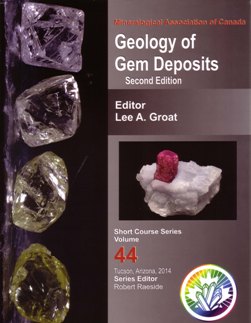Geology of Gem Deposits
 Gemmology is an evolving science in which increasingly complex analytical techniques are used to confirm provenance and identity of valuable gemstones. Gemmologists are generally less interested in the origin and paragenesis of gemstones as in testing and classifying them.
Gemmology is an evolving science in which increasingly complex analytical techniques are used to confirm provenance and identity of valuable gemstones. Gemmologists are generally less interested in the origin and paragenesis of gemstones as in testing and classifying them.
For the geologist, particularly the mineralogist, they form an intriguing subset of the mineral kingdom. Gemstones may have a metamorphic or igneous origin, and/or develop along some kind of diffusion couplet. Understanding their paragenesis involves a combination of mineral chemistry, and aspects of fluid, metamorphic and magmatic processes.
This second edition of Geology of Gem Deposits arises out of a Mineralogical Association of Canada short course held at Tucson in 2014 and supersedes an earlier volume published in 2007. The format is much the same as the first volume. An opening chapter on diamond is followed by chapters on gem corundum deposits (including ruby and sapphire), emerald, non-emerald beryl, chrysoberyl, tsavorite and tanzanite, topaz, gem-bearing pegmatites, and jade (jadeite jade and nephrite jade). A general discussion on the geology of gems and their geographic origin separates the chapters on corundum and emerald. The volume closes with an overview of Canadian Coloured Gemstones supported by nine pages of colour images. The book runs to 393 pages with some chapters greatly increased in length, including that on corundum (now 84 pages long) and that on tsavorite and tanzanite. Most of the diagrams are the same, although many have been rendered into colour making the volume more visually attractive. Another enhancement is that colour images of gemstones and gem bearing rocks have been embedded into the text rather than being included in a series of separate colour pages, giving them more immediacy.
For anybody interested in gemstones from a geological perspective, this is a wonderful book. All the authors are well known in their field, although I note that in the index not all chapters have authors attributed to them. Scientifically up to date, well put together and well-illustrated with appropriate use of colour this is an attractive book to dip into. If I have a pedantic quibble it is that there is no consistent format between chapters. Each is written as a stand-alone paper so geology and geography are dealt with in different ways. My main disappointment is in the “Geology of Gems and their Geographical Origin”. This could have been a major statement but ends up being rather bland and uncontroversial.
Reviewed by Peter Treolar
Groat, L.E. (ed) 2014. Geology of Gem Deposits (2nd edition). Mineralogical Association of Canada, Short Course Series Volume 44. 405 pp. ISBN 978-0-921294-54-2